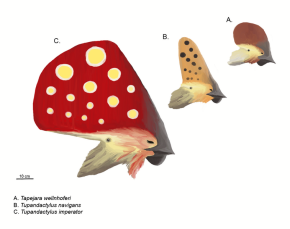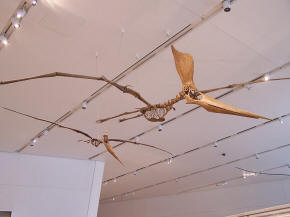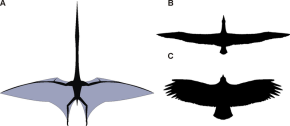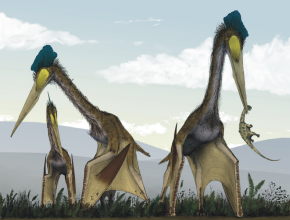|
Pterosaurs are sometimes referred to in the popular
media as dinosaurs, but this is
incorrect. The term "dinosaur" is properly restricted to a certain group of
reptiles with a unique upright stance (superorder Dinosauria, which includes
birds), and therefore excludes the pterosaurs.
Pterosaurs are also incorrectly referred to as "pterodactyls",
particularly by journalists. This usage is discouraged. "Pterodactyl" refers
specifically to members of the genus
Pterodactylus, and
more broadly to members of the suborder
Pterodactyloidea.
Description
The anatomy of pterosaurs was highly
modified from their reptilian ancestors for the demands of flight. Pterosaur
bones were hollow and
air filled, like the bones of birds. They had a
keeled breastbone that was
developed for the attachment of flight muscles and an enlarged
brain that shows
specialized features associated with flight. In some later pterosaurs, the
backbone over the shoulders fused into a structure known as a
notarium, which served
to stiffen the torso during flight, and provide a stable support for the
scapula (shoulder
blade).
Wings
Pterosaur wings were formed by
membranes of skin and other tissues. The primary membranes attached to the
extremely long fourth finger of each
arm and extended along the sides of the body
to the legs.
While historically thought of as
simple, leathery structures composed of skin, research has since shown that
the wing membranes of pterosaurs were actually highly complex and dynamic
structures suited to an active style of flight. First, the outer wings (from
the tip to the elbow) were strengthened by closely spaced fibers called actinofibrils. The
actinofibrils themselves consisted of three distinct layers in the wing,
forming a crisscross pattern when superimposed on one another. The actual
function of the actinofibrils is unknown, as is the exact material from
which they were made. Depending on their exact composition (keratin, muscle,
elastic structures, etc.), they may have been stiffening or strengthening
agents in the outer part of the wing. The wing membranes also contained a
thin layer of muscle, fibrous tissue, and a unique, complex circulatory
system of looping blood vessels.
As evidenced by hollow cavities in the wing bones of
larger species and soft tissue preserved in at least one specimen, some
pterosaurs extended their system of respiratory air sacs into the wing membrane itself.
Skull, teeth and crests
Most pterosaur skulls had elongated,
beak-like jaws. Some advanced forms were toothless (such as the
pteranodonts and
azhdarchids), though
most sported a full complement of needle-like teeth. In some cases, actual
keratinous beak tissue
has been preserved, though in toothed forms, the beak is small and
restricted to the jaw tips and does not involve the teeth.
Pterosaurs are well known for their
often elaborate crests. The first and perhaps best
|

|
|
Reconstruction of crests three crested
tapejarids. From top to bottom: Tapejara wellnhoferi,
"Tapejara" navigans, Tupandactylus imperator (drawn to
scale). (Picture
Source)
|
known of these is the
distinctive backward-pointing crest of some
Pteranodon species,
though a few pterosaurs, such as the
tapejarids and
Nyctosaurus sported
incredibly large crests that often incorporated keratinous or other soft
tissue extensions of the bony crest base.
Since the 1990s, new discoveries and
more thorough study of old specimens have shown that crests are far more
widespread among pterosaurs than previously thought, due mainly to the fact
that they were frequently extended by or composed completely of keratin,
which does not fossilize as often as bone. In the cases of pterosaurs like
Pterorhynchus and
Pterodactylus, the
true extent of these crests has only been uncovered using
ultraviolet
photography. The discovery of Pterorynchus
and
Austriadactylus, both
crested "rhamphorhynchoids",
showed that even primitive pterosaurs had crests (previously, crests were
thought to be restricted to the more advanced
pterodactyloids).
Pycnofibres
At least some pterosaurs were
covered with hair-like filaments
known as
pycnofibres,
similar to but not
homologous (sharing a
common structure) with mammalian hair.
Pycnofibres were not true hair as seen in mammals, but a unique structure
that developed a similar appearance through
convergent evolution.
Although in some cases actinofibrils (internal structural fibres) in the
wing membrane have been mistaken for pycnofibres or true hair, some fossils
such as those of
Sordes pilosus (which
translates as "hairy demon") and
Jeholopterus ninchengensis
do show the unmistakable imprints of pycnofibres on the head and body, not
unlike modern-day bats, another example of convergent evolution. The
presence of pycnofibres (and the demands of flight) imply that pterosaurs
were endothermic
(warm-blooded).
The term "pycnofibre", meaning
"dense filament", was first coined in a paper on the soft tissue impressions
of Jeholopterus by
palaeontologist Alexander W.A. Kellner and colleagues in 2009.
History of
discovery
Most pterosaur fossils are poorly
preserved. Their bones were hollow and,
when sediments piled on top
of them, the bones were flattened. The best preserved fossils have come from
the Araripe Plateau, Brazil. For some
reason, when the bones were deposited, the sediments encapsulated the bones,
rather than crushing them. This created three-dimensional fossils for
paleontologists to study. The first find in the Araripe Plateau was made in
1974.
Most paleontologists now
believe that pterosaurs were adapted for active flight, not just gliding as was earlier
believed. Pterosaur fossils have been found on every continent. At least 60
genera of pterosaurs
have been found to date, ranging from the size of a small bird to wingspans
in excess of 10 metres (33 ft).
Natural
predators
Pterosaurs are known to have been
eaten by theropods. In the 1
July 2004 edition of
Nature, paleontologist
Eric Buffetaut
discusses an early Cretaceous fossil of three cervical vertebrae of a
pterosaur with the broken tooth of a spinosaur embedded in
it. The vertebrae are known not to have been eaten and exposed to digestion,
as the joints still articulated.
Reproduction
and life history
Fossils of pterosaurs only a few days to a week old
(called flaplings)
have been found, representing several pterosaur families, including
pterodactylids, rhamphorhinchids, ctenochasmatids and azhdarchids. All
preserve bones which show a relatively high degree of hardening (ossification)
for their age, and wing proportions similar to adults. In fact, many
pterosaur flaplings have been considered adults and placed in separate
species in the past. Additionally, flaplings are normally found in the same
sediments as adults and juveniles of the same species, such as the
Pterodactylus and
Rhamphorhynchus flaplings
found in the
Solnhofen limestone of
Germany, and Pterodaustro
flaplings from Brazil. All are found in deep aquatic environment far from
shore.
It is not known whether pterosaurs practiced any form of
parental care, but their ability to fly as soon as they emerged from the egg
and the numerous flaplings found in environments far from nests and
alongside adults has led most researchers, including Christopher Bennett and
David Unwin, to conclude that the young were only dependent on their parents
for a very short period of time, while the wings grew long enough to fly,
and left the nest to fend for themselves within days of hatching.
Alternatively, they may have used stored yolk products for nourishment
during their first few days of life, as in modern reptiles, rather than
depend on parents for food.
Growth rates of pterosaurs once they
hatched varied across different groups. In more primitive, long-tailed
pterosaurs ("rhamphorhynchoids")
such as
Rhamphorhynchus,
the average growth rate during the first year of life was 130% to 173%,
slightly faster than the growth rate of alligators. Growth in
these species slowed after sexual maturity, and it would have taken more
than three years for
Rhamphorhynchus
to attain maximum size. In contrast, the more advanced, large pterodactyloid
pterosaurs such as
Pteranodon grew to
adult size within the first year of life. Additionally, pterodactyloids had
determinate growth,
meaning that the animals reached a fixed maximum adult size and stopped
growing.
Extinction
It was once thought that competition
with early
bird species may have
resulted in the extinction of many of
the pterosaurs. By the end of the Cretaceous, only large species of
pterosaurs are known. The smaller species seem to have become extinct, their
niche filled by birds. However, pterosaur decline (if actually present)
seems unrelated to bird diversity. At the end of the Cretaceous period, the
great extinction which wiped out all non-avian dinosaurs and most avian
dinosaurs as well, and many other animals, seemed to also take the
pterosaurs. Alternatively, most pterosaurs may have been specialised for an
ocean-going lifestyle. Consequently, when the K-T mass-extinction
severely affected marine life that most pterosaurs fed on, they went
extinct.
Well-known
genera
Examples of pterosaur genera include:
 |
Pteranodon was 1.8
metres (six ft) long, with a wingspan of 7.5 m (25 ft), and lived during
the late Cretaceous period.
|
 |
Pterodactylus had
a wingspan of 50–75 centimetres (20 to –30 inches), and lived during the
late Jurassic on lake shores.
|
 |
Pterodaustro was a
Cretaceous pterosaur from
South America with
a wingspan around 1.33 metres and with over 500 tall, narrow teeth, which were
presumably used in filter-feeding, much like modern
flamingos. Also
like flamingos, this pterosaur's diet may have resulted in the animal
having a pink hue. It was
South America's first pterosaur find.
|
 |
Quetzalcoatlus had
a wingspan of 10–11 metres (33–36 ft), and was among the largest flying
animals ever. It lived during the late Cretaceous period.
|
 |
Hatzegopteryx was
the largest flying animal known to science. Although no complete fossil
has been descovered, what little fossils paleontologists
have found give the creature an estimated
wingspan of roughly 12 metres (40 ft.)
|
In
popular culture
Pterosaurs have been a staple of popular culture for as
long as their cousins the dinosaurs, though they are usually not featured as
prominently in films, literature or other art. Additionally, while the
depiction of dinosaurs in popular media has changed radically in response to
advances in paleontology, a mainly outdated picture of pterosaurs has
persisted since the mid 20th century.
The number and diversity of
pterosaurs in the popular consciousness is also not as high as it has been
historically for dinosaurs. While the generic term "pterodactyl" is often
used to describe these creatures, the animals depicted frequently represent
either
Pteranodon or
Rhamphorhynchus, or a
fictionalized hybrid of the two. Many children's toys and cartoons feature
"pterodactyls" with Pteranodon-like
crests and long,
Rhamphorhynchus-like
tails and teeth, a combination that never existed in nature. However, at
least one type of pterosaur did
have at least the Pteranodon-like
crest and teeth—for example, the
Ludodactylus, a name
that means "toy finger" for its resemblance to old, inaccurate children's
toys.
Pterosaurs were first used in
fiction in Arthur Conan Doyle's 1912 novel
The Lost World, and
subsequent 1925 film adaptation. They have been used in a number of films
and television programs since, including the 1933 film
King Kong, and 1966
One Million Years B.C..
In the latter, animator
Ray Harryhausen had to
add inaccurate bat-like wing fingers to his stop motion models in order to
keep the membranes from falling apart, though this particular error was
common in art even before the film was made. Pterosaurs were mainly absent
from notable film appearances until 2001, with
Jurassic Park III.
However, paleontologist Dave Hone has noted that even after the 40
intervening years, the pterosaurs in this film had not been significantly
updated to reflect modern research. Among the errors he noted as persisting
from the 1960s to the 2000s were teeth even in toothless species (the
Jurassic Park III
pterosaurs were intended to be Pteranodon,
which translates as "toothless wing"), nesting behavior that was known to be
inaccurate by 2001, and leathery wings, rather than the taut membranes of
muscle fiber which was actually present and required for pterosaur flight.
A fictionalized mutation of a
pterosaur was introduced in the 1956 Japanese film
Rodan. The film was
released by
Toho, the same studio
responsible for
Godzilla. The
character later appeared in a number of Godzilla films between 1964 and
2004.
Return to the
Old Earth Ministries Online Dinosaur
Curriculum homepage.

|



